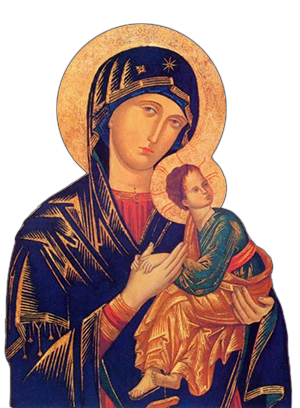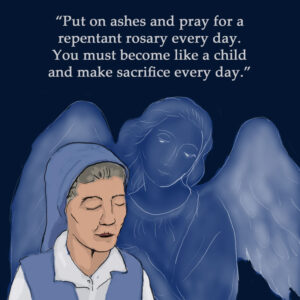Father Linus Clovis: Our Lady of La Salette
Today is the feast of Our Lady of La Salette. [September 19th]
In the year 1846, Saturday the 19th of September, Our Blessed Lady appeared to two children in the mountains around the village of La Salette.
The two children, a boy, Maximin Giraud, and the girl, Mélanie Calvat, were strangers to each other. It was providence that they happened to be asked by their respective employers to take the cows to the mountains for grazing. Maximin was just 11 years old and Mélanie was 14.
And so, the first day, which would have been the Friday, they the went to the mountains. And their relationship was very strained because both of them were very strange children. They were very taciturn, Mélanie didn’t like speaking to people, and Maximin was himself a very outgoing child.
The second day, which would be the Saturday, they both went again and they decided to build a little garden whilst the cows were grazing. And after they’d built this garden, they fell asleep. And suddenly, Mélanie awoke in alarm because she’d fallen asleep in the mountains, and she had no idea where the cows were. So she ran looking for them. And while she was doing this, she was shouting, so Maximin followed her. And then they saw the cows were peacefully grazing at some distance away. So they returned to their little garden and were surprised to see that, on the rock around which they built the garden, there was a woman.
First of all, they saw this globe of light, which grew bigger and bigger, and then the light opened up to reveal a woman sitting on the rock. Her elbows were on her knees, her head was in her hands, and she was weeping bitterly.
In fact, the children later described their impression; they said they felt it was a woman who had been beaten by her children, and that she had come to the mountains to weep privately.
But the initial reaction on seeing this was the sense that it was they who were going to be attacked and so Mélanie grabbed her her staff, the one she shepherded the cows with, and said if it attacks us, I would beat it. But the lady stood up, still weeping, and said, “my children come closer. Do not be afraid.” And as they came, they saw (because now she’s standing) that she was wearing this beautiful white dress, very similar to that worn in the region, and that she had a gold apron which went down to her ankles. Her shoes were white and around her neck were two chains; a very heavy chain and a very light, a lighter chain. And on the lighter chain was a crucifix with the pinchers and the hammer; the instruments used during the Passion of Our Lord. And the image itself glowed. On her head was a crown or, rather, a headdress which had the appearance of a crown, and there were roses–gardens of roses–on her head, on her shoulders, and on her shoes.
And, still weeping, she said to them, my children she said, how I suffer so much. I can no longer restrain the hand of my son. His arm is very heavy, his arm of justice, and all of this because of two sins. She says, all of this, because the people here will continually use his name as a curse and, although they have six days for work, they refuse to honor my son on the Sabbath. She said, I have suffered so much that even if you were to make reparation now, it would not avail. You can never make sufficient reparation for what I have undergone.
And then she went on to speak about the famine. She said despite all the work that you do, this will not feed you, your children will die. She went on to say that because of these two sins, blasphemy and the violation of the Sabbath, she said that there would be a famine, and that the potatoes, even if planted, would rot in the ground and the wheat itself will not bear fruit. She went on to speak about the grapes.
And in fact, in 1847, and the following year, 1848, there was the great famine in Europe. In particular, it struck Ireland–so much so that many Irish left their homelands to go to the US and to Australia and to other parts of the world.
Having spoken these words, she then departed. And then as she was going, she looked across towards the mountains so she was looking south and to Rome, and she said to the children that even in Rome, the faith would be lost. She also entrusted to the two children separately, individually, a secret, so that neither knew the secret of the other.
What is striking about this apparition was that it was believed almost instantly. The children returned to the village and Maximin told his employer what had happened. The employer believed him and immediately went to the employer of Mélanie. And they called her and questioned her, and she gave exactly the same story as Maximin had done. And these were two children who were not educated, they were simple, simple children. And the employers believed them. The priest was informed, and he believed. And so this is very unusual because ordinarily there’s lots of skepticism.
The following day the there was a procession to the mountains. And they found that from the rock on which the lady sat, there was a fountain of spring water flowing, and it flows even to to this day. And so the bishop, in turn, was informed, and he set up a commission. And within five years, the commission reported favorably. And the bishop issued a declaration in 1851, on the 19th of September (the anniversary), saying that this apparition, this story was worthy of belief.
And so the devotion to Our Lady of La Salette began.
What was striking, the children would not reveal the secrets until the bishop had said to them, but surely Our Lady would not object to the Pope knowing the secret. And the children asked, well who is the Pope? They had no idea. When it was explained to them that he was the successor of Saint Peter and the head of the Church, they agreed to the secret being written down, sealed, and delivered personally to the Pope, which was done. And the Pope, Blessed Pius IX, received it, read it, and said, I believe this.
What the contents of the secret are have not yet, even today, been revealed. But what is certain is that Our Lady implied that there would come a time when even Rome would lose its faith. This apparition is also tied into the apparition of Our Lady of Knock, which would happen in 1879, and later, to Fatima in 1917. So much so, that Eugenio Pacelli, who would become Pius XII in the 1930s, said, I’m very troubled by the messages of the little children (he was referring to Fatima) and, in particular, the call that I hear all around me (this is the 1930s) that the Church should change her ways. In particular, he went on to say, that the Church should reproach herself for her history, for what she has done, that the sanctuary itself should be changed, and that the liturgy should be amended. All of this in 1930s.
The apparition of Our Lady of La Salette takes us also back to the Scriptures because, again the image, she’s sitting on the rock, she is in tears, she’s weeping about the sins of blasphemy and the sins of violation of the Sabbath, she is talking about the divine vengeance that she can no longer support it.
The only person in the Old Testament who is associated with a rock is Moses. The rock on many occasions appears in his life story and the two most significant occurrences are, of course, the rock that followed them through the wilderness on which Moses was instructed to stand and to strike, which, when he did, water flowed out for the for the people–so much so that they had water for themselves and for the animals.
The second occurrence of significance was when Joshua was fighting the Amalekites in the valley and Moses was up on the hill he had his arms outstretched in a form of a cross and as long as he held the rod, as long as he had his arms raised, Joshua and the Israelites had the advantage. When because of fatigue, his arms dropped, then the Amalekites had the advantage. And so the his two assistants, Hur and Caleb, came to Moses and they supported his arms so he could keep the the battle in favor of the Israelites. But then he also grew tired and then, we’re told specifically, he sat on the rock.
In the New Testament, we have the reference to the rock which we immediately associate with Peter. And Our Lord who says after Peter had confessed him to to be the Christ, the son of the living God, Our Lord called Peter the rock. “Blessed are you, Simon bar Jonah, for flesh and blood does not reveal this to you, but I say to you, you are Peter the rock, and on this rock, I will build my church and the gates of the underworld can never prevail against it. So when Our Lady looked south and lamented that Rome, even Rome, would lose its faith, we need to ask ourselves, well how can that be when Our Lord has promised the gates of the hell should never prevail against his church?
What is the faith then that we need to hold on to? And, in fact, in the Gospel of today, we were told that we should not be deceived. Ultimately, the faith that we must hold on to, we must remain firm in, is that Christ is the rock; he’s the one that followed the Israelites through the wilderness, the one that Moses struck. And, of course, when Moses struck the rock, it was a symbol also of the soldier who pierced the side of Our Lord on Cavalry; he struck that rock. The rock that Peter confessed and in which his faith is built is that Christ is the son of the living God; Christ is God, that there’s no other name by which we might be saved, that he alone is the way, the truth and the life. And this is the fundamental doctrine that we must hold on to.
The others indeed are dependent on this because, if Christ is not God then our religion is not divine; it is a man-made religion like all the others. But if Christ is the Son of God–which he is–then we are certain that our religion comes from God and therefore, even though many are deceived, as we heard in the Gospel, many will fall away, as we heard in the Gospel, we can be certain nonetheless, it will last as he promised until his return.
Therefore, we ask Our Lady of La Salette, who supports us with her tears, who intercedes for us with her sufferings and her tears to pray for us now, and at the hour of our death. Amen.
Video courtesy of Family Life International, transcript provided by WQPH



